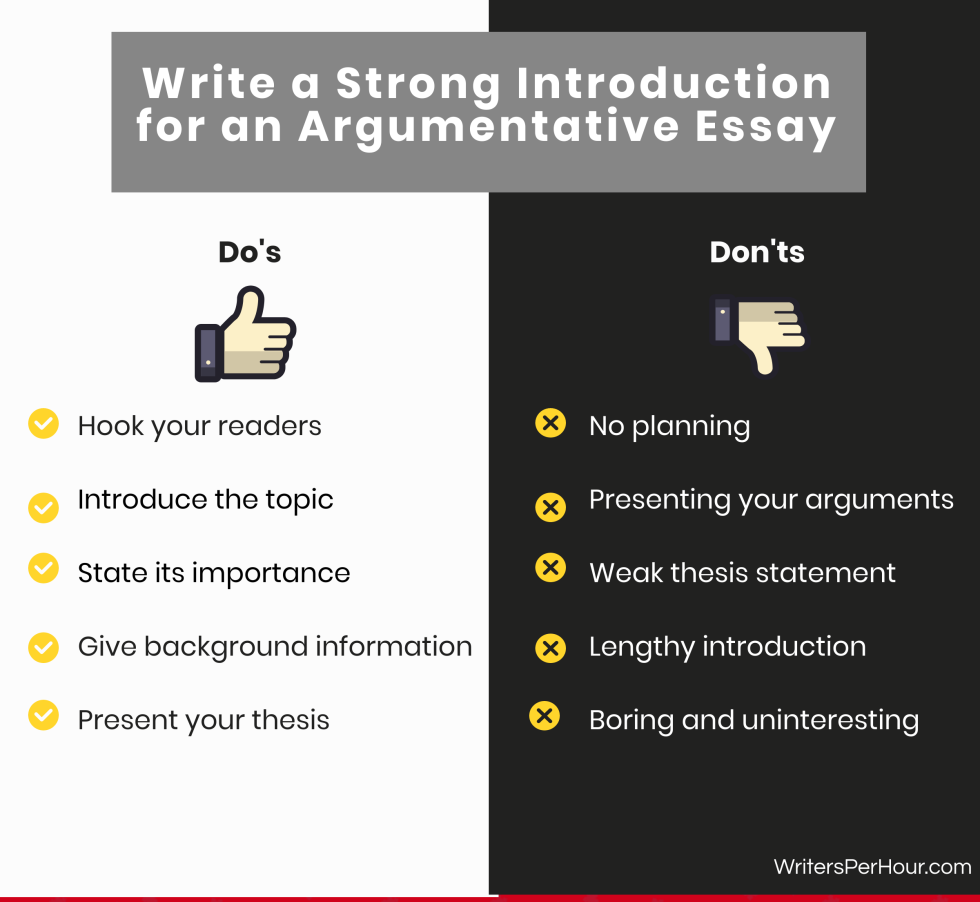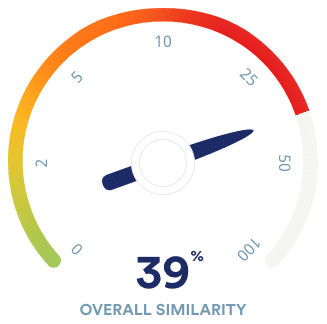
Merely introducing the topic is not enough. You need to tell readers why it’s important, the purpose behind choosing and most importantly, why should they bother reading it?
So, while outlining the entire essay, make sure you get specific and make a note of how your introduction will flow. You can also state the pointers you intend to include in bullet points.
Here are the five most common mistakes students make while writing an introduction for an argumentative essay.
After reading your introduction, people need to want to read the rest of the argumentative essay - that’s the impact your introduction should have.
1. Hook your readers
However, if your essay is 1,000 words, don’t spend more than four or five paragraphs on the introduction.
So, here are five tips to keep in mind while writing an introduction for an argumentative essay and begin on a strong note.
There’s a lot riding on introductions. After all, it’s the first thing people read and it gives an indication of what the rest of your essay is going to be like.

The introduction usually starts by providing some background information to your particular topic, so the reader understands the key problem being addressed and why it is an issue worth writing about. However, it is important that this is brief and that you only include information that is directly relevant to the topic.
State your position on the topic (also referred to as your main argument, or contention, or thesis statement). Make sure that you are directly answering the question (and the whole essay question if there is more than one part!).
Setting the parameters of the essay is important. You can’t possibly cover everything on a topic - and you are not expected to - so you need to tell your reader how you have chosen to narrow the focus of your essay.
An essay is not like a mystery novel which keeps the reader in suspense
Key elements of an introduction
B usiness leadership has been described as the ‘ability to influence, motivate and enable others to contribute to the effectiveness and success of the organisations of which they are members’ (House, Hanges, Javidan, Dorfman, & Gupta, 2004, p. 63). Whether this ability is something a person is born with, or whether it is something that a person can learn, has been the subject of considerable debate. Kambil (2010) has outlined two categories of leadership attributes that help to frame the discussion: 'traits' (mostly innate) and 'skills' which can be developed through experience or training. This essay will draw on the trait theory of leadership to argue that that leaders are first born, but then must be made. While good business leaders share certain traits that are essential to success, including ‘curiosity, courage, perseverance, personal ethics and confidence’ (Kambil, 2010, p.43), they also need learnable skills, such as communication, negotiation and conflict resolution, that are only developed through practice. A potential leader should develop their natural traits as well as learn and practise skills which will help them to persuade, equip and inspire others to realise their vision.
When writing an introduction, you should typically use a ‘general to specific’ structure. That is, introduce the particular problem or topic the essay will address in a general sense to provide context, before narrowing down to your particular position and line of argument.
The purpose of the introduction is to give your reader a clear idea of what your essay will cover. It should provide some background information on the specific problem or issue you are addressing, and should clearly outline your answer. Depending on your faculty or school, ‘your answer’ may be referred to as your position, contention, thesis or main argument. Whatever term is used, this is essentially your response to the essay question, which is based on the research you have undertaken.

When you’ve finished writing the essay body and conclusion, you should return to the introduction and check that it matches the content of the essay.
This introduction to a short expository essay leads into the topic (the invention of the printing press) and states the main point the essay will explain (the effect of this invention on European society).
This introduction to an argumentative essay sets up the debate about the internet and education, and then clearly states the position the essay will argue for.
Example: Signposting This essay begins by discussing the situation of blind people in nineteenth-century Europe. It then describes the invention of Braille and the gradual process of its acceptance within blind education. Subsequently, it explores the wide-ranging effects of this invention on blind people’s social and cultural lives.
Step 5: Check and revise
A thesis statement is a sentence that sums up the central point of your paper or essay. Everything else you write should relate to this key idea.
Particularly in longer essays, it’s helpful to end the introduction by signposting what will be covered in each part. Keep it concise and give your reader a clear sense of the direction your argument will take.
- Catch your reader’s attention.
- Give background on your topic.
- Present your thesis—the central point of your essay.

- It gives your writing direction and focus.
- It gives the reader a concise summary of your main point.
To write a good hook, avoid overly broad statements or long, dense sentences. Try to start with something clear, concise and catchy that will spark your reader’s curiosity.
When you’ve finished writing the essay body and conclusion, you should return to the introduction and check that it matches the content of the essay.
- An opening hook to catch the reader’s attention.
- Relevant background information that the reader needs to know.
- A thesis statement that presents your main point or argument.
More examples of essay introductions
This introduction to a short expository essay leads into the topic (the invention of the printing press) and states the main point the essay will explain (the effect of this invention on European society).
Example: Signposting This essay begins by discussing the situation of blind people in nineteenth-century Europe. It then describes the invention of Braille and the gradual process of its acceptance within blind education. Subsequently, it explores the wide-ranging effects of this invention on blind people’s social and cultural lives.
Without a clear thesis, an essay can end up rambling and unfocused, leaving your reader unsure of exactly what you want to say.
I have introduced the topic with necessary background information.

So, while outlining the entire essay, make sure you get specific and make a note of how your introduction will flow. You can also state the pointers you intend to include in bullet points.
So, here are five tips to keep in mind while writing an introduction for an argumentative essay and begin on a strong note.
Let’s first understand the purpose of the introductory paragraph. The point of the introduction is to introduce the topic while drawing readers in and making them intrigued to know more.
Look at this step as getting your readers on the same page. When you do that, they’re in a better place to understand your arguments.
5 Common Mistakes to Avoid While Writing an Introduction for an Argumentative Essay
It cannot be a general statement - it needs to be debatable such that people can agree or disagree with it. At the same time, it needs to be focussed on a specific topic as opposed to being vague or broad.
After writing an enticing hook, you need to go on to introduce your topic which includes what you’re going to be writing about.
Students often get swayed while writing introductions without realizing that the main portion of the essay is yet to come.
The argumentative essay’s thesis statement should be a crisp and clear explanation of the main argument of your essay.
